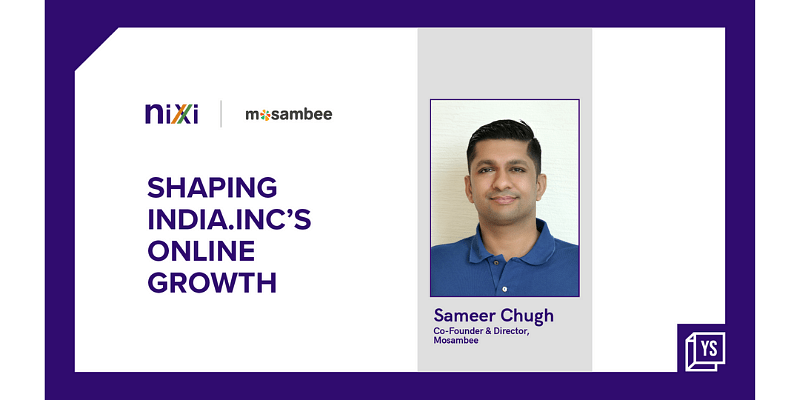In 2012, cash was the dominant transactional medium and the country was ripe for innovation and disruption for ease of transactions and payments, remembers Sameer Chugh. Over a dinner table conversation, Sameer along with Alok Arora and Bhushan Thaker found themselves discussing different trends in the market, which eventually led them to launch Mosambee.
The beginning
While Alok and Bhushan are IT veterans and have been involved in the BFSI space for over 30 years, Sameer is from a consulting background. The latter got introduced to the duo through a mutual connection, and they embarked on this journey together. “Mobile point of sale (POS) had just been launched in the US as a really interesting product. It had the potential to reduce payment acceptance and infrastructure costs. Earlier the machines used to cost around Rs 10,000 – 12,000, but these cost Rs 2,000. There’s almost an 80 percent cost reduction in the infrastructure and deployment of digital payments and it made sense for a market like India,” explains Sameer.
After identifying mPOS as the solution they wanted to explore, the team realised that they could increase penetration by 5x in just three to five years. Once they had locked in on the product, there was no stopping them. They got together and launched Mosambee in 2012. “Eight years later, we are still continuously innovating and helping SMEs digitise,” adds Sameer.
Since their inception, Mosambee has aimed to transform the existing payment infrastructure and help MSMEs in India leverage innovative solutions to capitalise on untapped revenue streams. Digitising the entire merchant experience was a big goal for the team. Sameer explains, “When a consumer comes to the store and wants to pay the merchant, merchants should be able to accept beyond just cash. We wanted to make sure that the merchant doesn’t refuse the customer. Of late, various operations are going digital and payment is a very small part of it, but a great entry point. We believe in digitising the entire merchant behaviour.”
Mosambee’s flagship product mPOS can mobilise transactions and transform businesses. Small business owners can accept debit and credit cards by using a simple EMV device that connects to a mobile phone using Bluetooth. Mosambee also offers a one-stop solution, Zyadashop, to help merchants leapfrog into e-commerce. Small merchants can create an online catalogue for their products and share this with their customers to drive online sales.
Overcoming challenges with a .in domain
The journey wasn’t easy as a startup in India’s regulatory-driven fintech ecosystem. Sameer explains that managing things from a regulatory perspective and corporate law perspective was essential. Building trust as a startup in the payment space was also a challenge. “How do you create trust amongst merchants, or businesses or banks that you work with? They need to know about you, they need to know you are legitimate and not just a fly-by-night company. Therefore, it is important to have an online presence, which means that people should be able to discover you online and find out more about you,” says Sameer.
As Mosambee was a digital-first company, they have no physical branches or offline direct presence. “While our products support payment transactions in real-time, we have been into what in the payments business is called ‘offline’ space. Customers were physically present in merchant stores and were transacting using mPOS machines. With our setup, we have moved discovery of our services online and delivery of our services in the offline world. As the country was under lockdown, we helped merchants move online with our product Zyadashop,” shares Sameer.
Mosambee’s .in domain is helping them gain trust, especially among MSMEs keen on developing business relationships in the local community. He adds, “The domain also showcases that we’re a made-in-India brand working towards resolving the challenges of Indian merchants. With a .in domain, it is easier for us to reach small merchants located in Tier II and Tier III cities.”
Like Mosambee, various companies across sectors have opted for the .in domain name. The National Internet Exchange of India (NIXI) has helped various businesses across sectors easily get access to a .in or .Bharat domain. Companies can choose between 22 languages for a domain name after opting for .in and .Bharat.
The .in domain helps build brand recall and also enables brands to leverage innovative solutions to offer hand-crafted customer experience, helping small businesses stand out. “It was quite easy for us to register the domain name with a .in extension. In fact over the last few years, we have registered over 10 .in domains for various products and launches,” he says.
The way forward
For Mosambee, the focus is clear – to build trust and create value for customers. What started out as a team of three is today an organisation of 500. Touching over a million stores, Sameer reveals that Mosambee was the first company in the fintech startup ecosystem to pay dividends to their investors. “It is not just about making large announcements and raising money, we are also focused on building a solid business. We’ve grown well in terms of numbers. Four years ago, our revenue used to be around Rs 1.5-2 crore, and last year, we did about Rs 140 crore,” he says.
In the next couple of years, Mosambee hopes to continue building products and reaching more merchants. Their focus is to take the SME merchant online so that they have enough power to be able to offer their value proposition to their customers in comparison to the large websites or e-commerce players. “India is a very hybrid market, it is not going to go all online; there will always be general trade and your offline stores as well and we wish to empower them. We are already present in about a million stores and we want to help 10 million merchants in the next three to five years,” he says.
The ‘Shaping India Inc’s Online Growth’ series chronicles the journeys of startups and SMEs in India and how creating an online presence on the .in or .Bharat domain powered their success stories.










